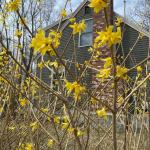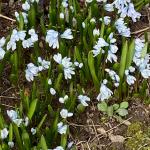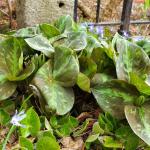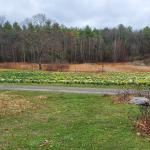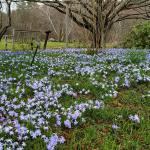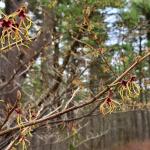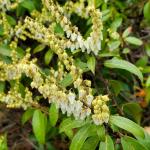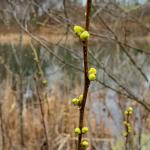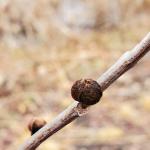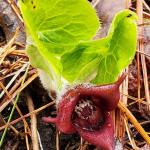UMass Extension's Landscape Message is an educational newsletter intended to inform and guide Massachusetts Green Industry professionals in the management of our collective landscape. Detailed reports from scouts and Extension specialists on growing conditions, pest activity, and cultural practices for the management of woody ornamentals, trees, and turf are regular features. The following issue has been updated to provide timely management information and the latest regional news and environmental data.
Well-Wishes for a Healthy, Safe 2020 Season from the Landscape, Nursery, and Urban Forestry Program
Dear Landscape Message Readers,
As we begin this surreal 2020 growing season, everyone here at UMass Extension hopes that you, your families, friends, coworkers, clients, and communities are healthy and prioritize safety, above all. For the Green Industry professionals in Massachusetts, the prioritization of safety will not come as an unusual activity, despite the particularly unfamiliar circumstances we all currently find ourselves in.
UMass Extension is abiding by the current Massachusetts and University policy which has the effect of temporarily suspending most of the on-campus and in-person services we provide. However, our professional staff and the contributors to the Landscape Message are working remotely while following public health guidance and hope to continue to provide the useful and science-based information for landscapers, arborists, turf managers, nursery growers, garden designers, and other practitioners that you have come to expect from this publication.
We recognize that families, Green Industry businesses, communities, and our Commonwealth have been dramatically impacted by COVID-19. We encourage everyone to stay up-to-date with the latest guidance from the MA Department of Public Health and the federal Centers for Disease Control and Prevention here: https://www.mass.gov/resource/information-on-the-outbreak-of-coronavirus-disease-2019-covid-19 .
Stay safe everyone, and know that we are thinking of you and doing our best to maintain and expand our remote educational offerings at this time.
Sincerely,
Tawny Simisky
Extension Entomologist
Interim Team Leader of the Landscape, Nursery, and Urban Forestry Program
The Landscape Message will be updated weekly in May. The next message will be posted on April 24. To receive immediate notification when the next Landscape Message update is posted, be sure to join our e-mail list.
To read individual sections of the message, click on the section headings below to expand the content:
Scouting Information by Region
Environmental Data
The following data was collected on or about April 8, 2020. Total accumulated growing degree days (GDD) represent the heating units above a 50° F baseline temperature collected via our instruments for the 2020 calendar year. This information is intended for use as a guide for monitoring the developmental stages of pests in your location and planning management strategies accordingly.
|
Region/Location |
GDD |
Soil Temp |
Precipitation |
Time/Date of Readings | |||||
| 2019 Total | 2020 Current | Sun | Shade | Since 1/1 | Since 4/1 | ||||
|
Cape Cod |
2626 | 10.0 | 46 | 44 | 11.01 | 1.58 | 10:00 AM 4/8 | ||
|
Southeast |
2875 | 16.5 | 53 | 45 | 10.25 | 1.62 | 2:30 PM 4/8 | ||
|
North Shore |
2642 | 32.5 | 47 | 41 | 10.44 | 0.58 | 2:00 PM 4/8 | ||
|
East |
2930 | 45.5 | 54 | 47 | 11.30 | 1.87 | 5:00 PM 4/8 | ||
|
Metro West |
2699 | 30.0 | 47 | 44 | 8.82 | 1.11 | 6:30 AM 4/8 | ||
|
Central |
2664 | 30.0 | 42 | 42 | 12.33 | 1.19 | i:00 PM 4/8 | ||
|
Pioneer Valley |
2669 | 15.5 | 50 | 44 | 9.39 | 0.52 | 12:00 PM 4/8 | ||
|
Berkshires |
2361 | 9.5 | 46 | 44 | 7.60 | 0.20 | 9:00 AM 4/8 | ||
|
AVERAGE |
2683 | 24.0 | 48 | 44 | 10.00 | 1.10 | - | ||
|
n/a = information not available |
|||||||||
Phenology
| Indicator Plants - Stages of Flowering (BEGIN, BEGIN/FULL, FULL, FULL/END, END) | ||||||||
|---|---|---|---|---|---|---|---|---|
|
PLANT |
CAPE |
SE |
NS |
EAST |
METRO |
CENT |
PV |
BERK |
|
Magnolia stellata (Star Magnolia) |
Begin/Full |
Full |
Begin/Full |
Begin/Full |
Begin |
Begin/Full |
Begin/Full |
* |
|
Forsythia x intermedia (border Forsythia) |
Full |
Full |
Full |
Full |
Full |
Full |
Full |
Full |
|
Pieris japonica (Japanese Pieris) |
Full |
Full |
Full |
Full |
Full |
Full |
Full |
* |
|
Cornus mas (Cornelian cherry dogwood) |
Full/End |
Full/End |
Full |
Full/End |
Begin/Full |
Full |
Full |
Full |
|
Acer rubrum (red maple) |
Full |
Full |
Full |
Full |
Full |
Full |
Full |
Full |
|
Acer saccharinum (silver maple) |
* |
Full |
End |
Full/End |
Full |
Full |
Full |
* |
|
Hamamelis x intermedia (witchhazel hybrids) |
* |
End |
End |
End |
Full/End |
Full/End |
End |
* |
| * = no activity to report/information not available | ||||||||
Regional Notes
Cape Cod Region (Barnstable)
General Conditions:
|
Month |
Average °F |
High °F |
Low °F |
Precipitation (inches) |
GDD |
|
December |
37 |
58 (12/10) |
14 (12/19) |
8.98 |
2626 |
|
January |
36 |
64 (1/12) |
13 (1/18) |
2.05 |
4.5 |
|
February |
37 |
56 (2/7) |
16 (2/15) |
3.89 |
4.5 |
|
March |
42 |
61 (3/9) |
19 (3/2) |
3.49 |
9.5 |
On average, the winter weather was mild. For much of the winter, precipitation (almost all rain here) would be accompanied by mild temperatures with cold stretches in between. The lowest temperatures reached were only in the mid-low teens. Most of the Cape never had frozen soil, with only the top inch or two freezing and thawing periodically in January. In mid to late February, it looked like it would be a very early spring as crocuses and silver maple were in full bloom. Since then plant development has slowed and normalized. Forsythia is now in full bloom as is red maple. Turf is slowly greening up. Soil moisture was excessive for much of the winter and those plants that don’t tolerate wet feet in the winter might have suffered. Both topsoil and subsoil moisture are adequate now.
Pests/Problems: Lecanium scale is still likely to continue to be the big story in this region as populations of the insect still remain very high throughout the Cape. On warm days in the last couple of weeks, the fine mist of honey dew under heavily infested trees has already been observed. This scale insect is primarily found on oak but can also be found on lots of other woody plants including tupelo, dogwood, Viburnum, apple, hickory, and more. Now is the ideal time to scout your woody plants for the presence of high scale populations. The ideal time to treat lecanium scale with dormant oil is 35-155 GDD base 50˚F. For more info: https://www.capecodextension.org/wp-content/uploads/2020/02/Lecanium_scale_HortNotes.pdf
Other insect and disease pests observed recently include phytophthora root rot on Nordmann spruce, black knot on Prunus, Volutella on boxwood, Cryptomeria scale on spruce (Abies spp), and scale on umbrella pine (Sciadopitys verticillata). Not much winter injury has been noted except on the usual plants like boxwood. Weeds in bloom include bittercress (Cardamine hirsuta), mouse-ear cress (Arabidopsis thaliana), fig buttercup (Ranunculus ficaria) and speedwell (Veronica spp). Every year there seems to be more inquiries about star-of-Bethlehem (Ornithogalum umbellatum) as a weed, very visible now in turf. Now is a good time to pull small woody invasive shrubs in the landscape. Rabbits! Ticks! Don’t forget to protect yourself from ticks!
Southeast Region (Dighton)
General Conditions: We've had a very mild winter with little snow cover but frequent rain. The soils are moist and the water table is high. The following plants are in flower: Daffodils, Narcissi, Chionodoxa, Scilla, Leucojum vernum, Muscari, Magnolia stellata, Pieris andromeda, Ulmus americana, Salix, Acer rubrum, ‘PJM’ Rhododendron, skunk cabbage, chickweed, hairy bittercress, ground ivy. Magnolia soulangeana is just beginning to bloom. Peach trees are at pre-bloom. Pink smartweed and lambsquarters have germinated and have their first set of true leaves. Garlic mustard, Norway maple, and violet seeds have germinated. Multiflora rose and Japanese honey suckle have leaved out.
Pests/Problems: Ticks are active.
North Shore (Beverly)
General Conditions: Welcome to the Landscape Message from Long Hill, Beverly, MA. Special thanks to Dan Bouchard, Superintendent at Long Hill for providing the information for this report.* This past winter was very mild with minimal snow fall. The month of March was unseasonably mild with temperatures averaging 42˚F. Since the beginning of April, day temperatures have been in the mid-40s to low 50s except for April 5th and 6th when day temperatures climbed to about 60˚F. Night temperatures have been mostly around 40 degrees. It has been a long bloom period for the plants in bloom because of the cool, damp weather. The weather forecast for the next few days calls for mostly sunny days and temperatures in the upper 40s to mid-50s. Rain showers are expected only on two days in the coming week. This will help accelerate plant growth and flowering for some trees and shrubs. Rain showers in the last few days have helped to keep the soil moist. Precipitation in March was only 2.2”. Woody plants observed in bloom include: Star Magnolia (Magnolia stellata), Cornelian cherry dogwood (Cornus mas), goat willow (Salix caprea), witch hazel (Hamamelis x intermedia), American filbert (Corylus americana), February Daphne (Daphne mezereum), border Forsythia (Forsythia x intermedia) and fragrant Viburnum (Viburnum farreri). Early spring flowering bulbs seen in bloom include: Siberian squill (Scilla siberica) and Puschkinia (Puschkinia libanotica), glory of the snow (Chionodoxa spp)and early daffodil (Narcissus spp.).
Pests/Problems: Wild turkey flocks have been observed in the landscape but no plant damage has been observed. Ticks resumed activity when temperatures started to rise above freezing. Protect yourself when working outdoors.
*Operations at UMass Amherst have been significantly reduced in response to the COVID-19 pandemic. All professional staff are working remotely, and unable to travel for work at this time. Because of these policy changes, sections of the North Shore regional report are currently unavailable. Environmental data and phenology have been provided by Daniel Bouchard, Senior Horticulturist, Trustees of Reservations and Superintendent at Long Hill. UMass Extension will continue to provide reporting information for the North Shore to the best of our ability.
East Region (Boston)
General Conditions: The winter has been unusually mild with minimal snowfall. January averaged 34°F with a high temperature of 71°F on the 12th. We recorded 1.43” of precipitation in January. February averaged 35°F with a high of 62°F on the 24th, a low of 7°F on the 15th and several minor rain/snow events totaling 3.77” of precipitation. March averaged 42°F with a high of 73°F on the 9th and a low of 18°F on March 1. Two significant rain events contributed to the March total of 4.23” of precipitation. The first 7 days of April, temperatures averaged 45°F with highs of 62°F on both April 6th and 7th. We have received 1.87” of rain so far this month, bringing the total precipitation to 11.3” for 2020. Over the past few weeks, a quiet calm has swept over the landscape. Plants are starting to leaf out, grass is greening up and spring blooms can be spotted. Birds have returned and are preparing for the year ahead. Many robins, blue jays, cardinals, woodpeckers, chickadees and other birds are beginning their mating rituals and building nests. Great horned owlets have hatched. Many perennials are starting to emerge including Hosta, peony, rhubarb, Sedum, and many others. Currently in bloom: Abeliophyllum distichum (white Forsythia), Cornus mas (Cornelian cherry dogwood), Forsythia ovata (Korean Forsythia), Helleborus spp. (hellebore), Magnolia stellata (star Magnolia), Magnolia × soulangeana (saucer Magnolia), Pieris japonica (Japanese Andromeda), Prunus spp. (cherries), Rhododendron mucronulatum 'Cornell Pink' (Korean Rhododendron). Spring bulbs currently in bloom include: garden hyacinths (Hyacinthus orientalis), Crocus (Crocus spp.), daffodils (Narcissus spp.), and Siberian squill (Scilla siberica).
Pests/Problems: Alliaria petiolata (garlic mustard) rosettes have been visible since late January and seedlings have now begun germinating in bare soil. Ficaria verna (lesser celandine) is flourishing in moist areas and is beginning to flower. The early red shoots of the invasive Fallopian japonica (Japanese knotweed) have emerged. Cardamine hirsuta (hairy bittercress) began flowering in mid-March. Dandelion (Taraxacum spp.) and common henbit (Lamium amplexicaule) are beginning to bloom. Pyrrhalta viburni (Viburnum leaf beetle) egg sites are visible on susceptible Viburnum twigs. Juniper, maple, poplar and Taxus have been contributing to the pollen count. Deer and rabbit damage is visible throughout the landscape. Squirrels have been observed digging up bulbs! Ticks are active.
Metro West (Acton)
General Conditions: Welcome to this year’s first landscape message from the Metro area! This past winter was mild. I did not record any sub-zero temperatures and recorded 0.2°F, the lowest temperature for the season on December 7th. However, I did record a run of single digit temperatures, our coldest spell for the season, ranging from 1°F to 7°F between January 20th and the 23rd. Additionally, moisture (snow) recorded for the months of January and February, 1.62” and 2.57” respectively, fell far short of their monthly averages. Spring arrived just three weeks ago and brought with it weather that is pretty typical for the season including warm and cool temperatures, hard frosts, wind, rain, thunder and lightning. Soils are saturated, leaf and flower buds are swelling on woody plants, and lawns are greening up. A high temperature of 65°F was recorded on April 7th, and a low temperature of 24°F was recorded on the 1st. Average rainfall for the month of March is 4.83” and the total recorded for last month was 3.34”. Average rainfall total for the month of April is 4.16” and as of the 7th, 1.11” has been recorded so far.
Pests/Problems: Ticks are active and deer are browsing.
Central Region (Boylston)
General Conditions: Warm temperatures and sunshine earlier this week were a welcome sign that spring is truly here. Despite the mild winter, spring blooms seem to be relatively close to last year’s timing. Amphibians have been active in wet areas for some time. Scilla siberica (Siberian squill), Chionodoxa luciliae (glory-of-the-snow), and Crocus have been actively blooming for two weeks or more, Forsythia exploded with the warm temperatures this week, as did Narcissus (daffodils). It’s still a bit early for many of our spring ephemerals. Jeffersonia dihpylla (twinleaf), Stylophorum diphyllum (wood poppy), and Mertensia virginica are showing signs of life and preparing to flower. Sanguinaria canadensis (bloodroot) and Anemone acutiloba (hepatica) are blooming. This is the time of year to spot flowers on our native wild ginger, Asarum canadense, before its leaves fully unfurl.
Pests/Problems: As others have noted, ticks are active and deer are browsing up a storm. Little winter damage has been noted on woody plants as of yet.
Pioneer Valley Region (Easthampton)
General Conditions: Welcome to our first installment of the 2020 Landscape Message in the Pioneer Valley. During this unsettled time when the UMass-Amherst campus is mostly closed, reports will be based out of my home in Easthampton. It was a pretty mild winter across Franklin, Hampshire and Hampden Counties and southern New England in general. We had one big snow storm in early December, with accumulations ranging from 12–18ʺ in the valley, while some hill towns recorded much higher totals. This hefty storm seemed a harbinger for a snowy winter but it was not to be. While December temperatures were mostly normal, the remainder of winter was mild. According to the Northeast Regional Climate Center, temperatures in January (>5°F above normal), February (3–5° above normal) and March (3–7° above normal) were much warmer than average throughout the valley. The first half of March was especially warm and helped to initiate an early spring flowering season. However, the latter half cooled off, which has prolonged flowering for some plants and slowed the development of others. In comparison to 2019, it seems flowering and plant development is at least two weeks ahead this year. Spring witchhazels started flowering on the UMass campus in late January and seemed to have an especially long bloom this year. Presently, Forsythia, Korean Rhododendrons, red/silver maple, willows and elms are in full bloom while catkins are developing on birch and alder. A few flowering cherries and purple PJM Rhododendrons are beginning to flower as well. Depending on the microclimate, crabapples and apples are flushing new leaves. The UMass Fruit Team is predicting early season apple scab infections will be initiating this week, especially in areas where leaf out may be more advanced, like southern Hampden County.
As is typical of early spring, soils are moist to wet at this time and the most recent U.S. Drought Monitor map shows no drought classifications throughout all of the northeast. While there’s been regular rainfall, the NWS River Forecast Center shows all the major rivers in the valley (Deerfield, Millers, Westfield, Chicopee and the Connecticut) several feet below flood stage right now. As a result of the high moisture, soil compaction is a major concern. To minimize soil compaction and still get to work, designate specific paths through larger landscape beds with mulch or stone. Also, you can place a few stones throughout interior portions of the garden that can serve as base points from which to work. For working from the edges of the bed, or if there’s enough space within larger beds, laying down a sheet of plywood is a good option (I use a 2 × 4′ sheet).
With many people working from home, I thought I would share a few things I’ve planted this spring in my own garden. When possible, I prefer to get plants in the ground early to help ease the effects of transplant shock and avoid planting when new growth is actively flushing. I spent a lot of time this past winter looking through tree and shrub books and settled on two “must haves” for this season: (1) Hollywood juniper (Juniperus chinensis ‘Kaizuka’); and (2) Thunderhead Japanese black pine (Pinus thunbergii ‘Thunderhead’). Both have unique and irregular forms even at a young age. Chinese juniper (J. chinensis)is regarded as more resistant to Gymnosporangium rusts compared to other juniper species. Rocky Mountain juniper (J. scopulorum)can be highly susceptible to cedar-quince rust (G. clavipes), which in turn can be very damaging to serviceberry (Amelanchier) and hawthorn (Crataegus). I’m hoping for more additions as the season progresses, like a weeping Serbian spruce (Picea omorika ‘Pendula Bruns’) to replace a badly disfigured blue spruce that the previous homeowner topped (twice). Additional introductions I’ve made include: Blue Planet white spruce (Picea glauca ‘Blue Planet’), Siberian cypress (Microbiota decussata) and Blue Rug juniper (Juniperus horizontalis ‘Wiltonii’). I placed the Siberian cypress in a foundation bed that receives only about two hours of direct sunlight per day and I’m interested to see how it performs in the shade. My wife has been busy dividing and moving Crocosmia corms, hellebores (Helleborus), primrose (Primula), daylilies (Hemerocallis), Virginia bluebells (Mertensia), and forget-me-nots (Myosotis), among others, and planting pansies (Viola).
Pests/Problems: As trees and shrubs begin to leaf out and develop new shoots, fungal pathogens will start initiating new infections. For most woody plants, that is still several weeks away. However, according to the UMass Fruit Team, primary apple scab infections are or will be taking place soon as apples and crabapples leaf out. You can read more about apple scab management for fruit trees in the UMass Tree Fruit Guide (https://netreefruit.org/apples/diseases/apple-scab) and this updated fact sheet (https://ag.umass.edu/landscape/fact-sheets/apple-scab). Continue to prune dead shoots and small branches from smaller trees and shrubs. Now that buds are swelling and flowering is starting, it’s easier to identify dead parts. Now is the time to scout for spruce spider mite (Oligonychus ununguis) on spruce, fir, and arborvitae, as well as other landscape conifers. This cool season mite is active early in the season but the damage typically becomes apparent in late spring. Before new growth emerges, soaps and oils can be used while numerous miticides are also labeled for use, like Floramite (Bifenazate). Avoid using broad-spectrum insecticides like imidacloprid, which will kill natural predators. Fertilizers that include imidacloprid should also not be used. White pine weevil damage is also a concern at this time, now that daytime temperatures are regularly exceeding 50°F. With an appropriate insecticide, protect the terminal shoot of young eastern white pine, Norway spruce and Douglas-fir growing in full sun. If you have an abundance of time on your hands, now is a good time to prune and clean out groundcovers like Vinca and Pachysandra. Because of the mild winter, winterberries may be hanging onto dead fruit. Gently remove these from the canopy to help limit the development and spread of diseases like anthracnose, which have been a problem in past years.
Berkshire Region (Great Barrington)
General Conditions: It has been an unusually mild winter. Year-to-date (YTD) heating degree days are at 5758 as compared to the norm of 6620. It has also been somewhat of a dry winter. Seasonal snowfall amounted to 37.6 inches compared to the norm of 58.6 inches. YTD precipitation is 7.47 inches while the norm is 10.19 inches. Despite the low precipitation figures, soils are quite moist but in most cases not saturated. Yet, they are wet enough that tilling would be difficult at this time. Lawns are beginning to green up and mowing will begin shortly. Snowdrops (Galanthus) remain in bloom in shaded sites but have faded in sunny locations. Daffodils, Lenten rose (Helleborus orientalis), Azalea ‘Cornell Pink’ (Rhododendron mucronulatum), skunk cabbage, and Iris reticulata 'Katherine Hodgkin’ are in bloom. Bud swell on deciduous trees and shrubs is quite noticeable and, at present, it doesn’t appear that winter injury will be a problem. Likewise, winter desiccation of evergreens is not apparent.
Pests/Problems: Adult black-legged ticks are abundant. Browsing by deer, rabbits, and woodchucks is a problem for emerging growth of herbaceous perennials. Wasps seem abundant but are somewhat lethargic. Perhaps the most prominent insect at this time is the multicolored Asian lady beetle, Harmonia axyridis, as they are a major household nuisance and can be found crawling on walls and windows, and occasionally on one’s dinner plate.
Regional Scouting Credits
- CAPE COD REGION - Russell Norton, Horticulture and Agriculture Educator with Cape Cod Cooperative Extension, reporting from Barnstable.
- SOUTHEAST REGION - Brian McMahon, Arborist, reporting from the Dighton area.
- NORTH SHORE REGION - Geoffrey Njue, Green Industry Specialist, UMass Extension, reporting from the Long Hill Reservation, Beverly.
- EAST REGION - Kit Ganshaw & Sue Pfeiffer, Horticulturists reporting from the Boston area.
- METRO WEST REGION – Julie Coop, Forester, Massachusetts Department of Conservation & Recreation, reporting from Acton.
- CENTRAL REGION - Mark Richardson, Director of Horticulture reporting from Tower Hill Botanic Garden, Boylston.
- PIONEER VALLEY REGION - Nick Brazee, Plant Pathologist, UMass Extension Plant Diagnostic Lab, temporarily reporting from Easthampton.
- BERKSHIRE REGION - Ron Kujawski, Horticultural Consultant, reporting from Great Barrington.
Woody Ornamentals
Diseases
The UMass Plant Diagnostic Lab remains closed to sample submission. However, when the lab is allowed to resume activities, we will make this information available. Presently, we can provide limited diagnostic support via phone and email, with the latter providing an opportunity for photos of the problem. We sincerely hope that green industry professionals struggling financially due to virus-related closures and cancellations can find a way to endure these weeks and resume normal operations in the future.
New or updated tree and shrub disease fact sheets:
1. Apple scab (https://ag.umass.edu/landscape/fact-sheets/apple-scab)
2. Root and Butt Rot caused by Phaeolus schweinitzii (https://ag.umass.edu/landscape/fact-sheets/root-butt-rot-caused-by-phaeolus-schweinitzii)
3. Root and Butt Rot caused by Kretzschmaria deusta (https://ag.umass.edu/landscape/fact-sheets/root-butt-rot-caused-by-kretzschmaria-deusta)
4. Beech Bark Disease (https://ag.umass.edu/landscape/fact-sheets/beech-bark-disease)
5. Powdery Mildew (https://ag.umass.edu/landscape/fact-sheets/powdery-mildew)
6. Fire Blight (https://ag.umass.edu/landscape/fact-sheets/fire-blight)
7. Target Canker of Hardwoods (https://ag.umass.edu/landscape/fact-sheets/target-canker-of-hardwoods)
8. Brown Rot of Stone Fruits (https://ag.umass.edu/landscape/fact-sheets/brown-rot-of-stone-fruits)
9. Phyllosticta Leaf Blotch (https://ag.umass.edu/landscape/fact-sheets/phyllosticta-leaf-blotch)
10. Root and Butt Rot caused by Bondarzewia berkeleyi (https://ag.umass.edu/landscape/fact-sheets/root-butt-rot-caused-by-bondarzewia-berkeleyi)
11. Trunk Rot caused by Climacodon septentrionalis (https://ag.umass.edu/landscape/fact-sheets/trunk-rot-caused-by-climacodon-septentrionalis)
Last year at this time, we were coming to grips with the widespread effects of winter injury on many broad-leaved evergreens. Rhododendrons and hollies were particularly hard hit, but Andromeda, azalea, mountain laurel and needled evergreens like arborvitae and false cypress were also badly damaged. While the exact cause at the time was difficult to identify, it’s most likely that very cold late autumn temperatures injured plants that had not properly hardened off, due to abnormally warm early autumn temperatures. Specifically, September of 2018 was very warm, and also wet, but temperatures plunged well below normal in November. We experienced another bitterly cold November in 2019, with temperatures 3–5°F below normal in the valley compared to historical averages. Low temperatures dipped <20°F on 11/9, 11/13–14 and 11/17. However, September and October of 2019 were not nearly as warm as the year prior, so plants were exposed to a more typical cold acclimation period. Regardless, based on the very cold November, I was concerned we would again see widespread winter injury this spring. Thankfully, Rhododendrons appear to have overwintered quite well and have a robust set of buds ready to flower.
According to the UMass Fruit Team, primary apple scab infections are or will be taking place soon as apples and crabapples leaf out. You can read more about apple scab management for fruit trees in the UMass Tree Fruit Guide (https://netreefruit.org/apples/diseases/apple-scab) and the updated fact sheet listed above. For many landscape crabapples, chemical management is not warranted but regular cultural care can help to ease the effects of the disease.
We will be carefully watching oaks this spring as they leaf out to determine if damage from the oak shothole leafminer appears again. Last year’s outbreak caught everyone by surprise and while many oaks were only mildly affected, some trees suffered significant injury to the canopy. In addition, there were a number of oak anthracnose cases early in the season that appeared to occur in conjunction with the shothole feeding wounds. Avoid pruning large limbs on oaks at this time to avoid attracting sap-feeding nitidulid beetles to these wounds. These small, native beetles are the primary overland vector of oak wilt, caused by Bretziella fagacearum. To date, oak wilt has NOT been detected in New England but has been found at several sites in New York (Upstate, New York City and Long Island). Thankfully, NY DEC has been very aggressive in containing these outbreaks when identified. Firewood containing the fungal pathogen remains a primary means of long-distance dispersal, while the beetles and root grafts provide local movement of the disease.
Be on the lookout this season for symptoms of beech leaf disease, caused by the nematode Litylenchus crenatae ssp. mccannii. The disease is confirmed in Fairfield County, CT along with Rockland, Westchester and Suffolk Counties in New York. Symptoms of infection include dark green, interveinal banding, distortion/curling of leaves and ultimately premature leaf shedding. Terminal buds are also colonized and aborted, resulting in no new leaf and shoot growth. Symptoms first develop in the lower canopy and spread upwards, resulting in tree death after many years. The rapid movement of the disease from the epicenter in northeast Ohio suggests it could soon spread into Massachusetts.
Report by Nick Brazee, Plant Pathologist, UMass Extension Plant Diagnostic Lab, UMass Amherst.
Insects
Spring 2020 is Here!
Springtime in the hilltowns of Hampshire County is always a few steps behind that of Amherst, MA. While I am used to scouting primarily in Amherst, for now my observations are limited to what I can see in the lovely town of Chesterfield, MA. Overwintered adult mourning cloak butterflies (Nymphalis antiopa) were observed in the lingering snow from the 5 inches we received on March 23, 2020. All of that has melted now, and mourning cloaks are still seen fluttering around. Mourning cloaks aren’t the only insects that you can find active early in the spring. In fact, some, such as woolly bear caterpillars, can be found wandering around even on warm days in January and February. There are many caterpillars that may be referred to as woolly bears, but this one in particular is the larval stage of the Isabella tiger moth or Pyrrharctia isabella. This species was a childhood favorite of mine, as I assume it is for many. (There’s a festival in Ohio for it! Awesome!) It is folklore that the total amount of black seen on the woolly bear in the fall is a predictor of the severity of the upcoming winter. Research does not support this, but still it is fun to show children the wonder of the woolly bear! Red maple buds are swelling and robins are singing and searching for food. On sunny days, neighbors can be seen walking up and down the road, soaking in the season change while practicing their social distancing. Despite the fact that this spring has been drastically different for so many of us in so many sometimes devastating ways, the familiarity of our landscapes “waking up” is something to hold onto and perhaps enjoy all the more.
Below are updates about some “big name pests”, in addition to insects that may be found on any springtime scouting list.
Woody ornamental insect and non-insect arthropod pests to consider, a selected few:
- Winter Moth: Operophtera brumata data since 2017 has indicated that the winter moth population in eastern Massachusetts has been on the decline while the percent of winter moth pupae parasitized by Cyzenis albicans has increased! This is excellent news, as it is data supporting the evidence that winter moth populations have decreased while the parasitic fly, C. albicans, has become established at many locations in New England. Dr. Joseph Elkinton’s laboratory at UMass Amherst has released this biological control of winter moth since 2005 and conducted the rigorous sampling required to determine where the insect has established and what its impact on the winter moth population has been at multiple sites in eastern MA. More information about the Elkinton Lab’s research and the biological control of winter moth can be found here: https://www.fs.fed.us/foresthealth/technology/pdfs/FHAAST-2018-03_Biology_Control_Winter-Moth.pdf
The take-home point? Do not worry about winter moth this spring! In fact, management of this insect in landscaped settings likely will not be necessary in most locations. In recent years, it is worth-while to note that some areas on the Cape and other locations in eastern MA have reported noticeable cankerworm populations in the spring, which are often confused for winter moth. Read more about cankerworms in the spring scouting list below.
In landscape settings in eastern Massachusetts, it is best to wait until the leaves of susceptible hosts completely unfold and monitor for feeding caterpillars, prior to treatment, especially since populations in Massachusetts continue to be so low in many locations. Be sure that management of this insect is necessary by monitoring for damaging populations before making applications in landscape settings. For more information about the life cycle and management of winter moth, please visit thisfact sheet: Winter Moth Identification and Management ( https://ag.umass.edu/landscape/fact-sheets/winter-moth-identification-management ).
Winter moth is a non-native insect that was identified in Massachusetts for the first time in 2003 following persistent reports of defoliation in eastern areas of the state such as Cape Anne and on the North Shore near Cohasset, Hingham, and Rockland on the South Shore in the late 1990’s. For more detailed information about the history of this insect pest in North America and Massachusetts, please visit this fact sheet: Winter Moth in Massachusetts: History and Biological Control ( https://ag.umass.edu/landscape/fact-sheets/winter-moth-in-massachusetts-history-biological-control ).
- Gypsy Moth:(Lymantria dispar) Thanks to the gypsy moth caterpillar killing fungus, Entomophaga maimaiga, the recent outbreak of gypsy moth in Massachusetts has come to an end! Most locations in Massachusetts will not see damaging or even noticeable populations of this insect in 2020. Gypsy moth has been in Massachusetts since the 1860's. This invasive insect from Europe often goes unnoticed, thanks to population regulation provided by the entomopathogenic fungus, E. maimaiga, as well as an NPV virus specific to gypsy moth caterpillars. (And to a lesser extent by many other organisms, including other insects, small mammals, and birds who feed on gypsy moth.) However, if environmental conditions do not favor the life cycle of the fungus, outbreaks of gypsy moth caterpillars are possible. (Such as most recently from 2015-2018, with a peak in the gypsy moth population in 2017 in Massachusetts.)
Missing gypsy moth already? Check out Episode 1 of InsectXaminer to reminisce about the 2015-2018 outbreak of this insect: https://ag.umass.edu/landscape/education-events/insectxaminer
- Asian Longhorned Beetle: (Anoplophora glabripennis, ALB) Look for signs of an ALB infestation which include perfectly round exit holes (about the size of a dime), shallow oval or round scars in the bark where a female has chewed an egg site, or sawdust-like frass (excrement) on the ground nearby host trees or caught in between branches. Be advised that other, native insects may create perfectly round exit holes or sawdust-like frass, which can be confused with signs of ALB activity.
The regulated area for Asian longhorned beetle is 110 miles2 encompassing Worcester, Shrewsbury, Boylston, West Boylston, and parts of Holden and Auburn. If you believe you have seen damage caused by this insect, such as exit holes or egg sites, on susceptible host trees like maple, please call the Asian Longhorned Beetle Eradication Program office in Worcester, MA at 508-852-8090 or toll free at 1-866-702-9938.
To report an Asian longhorned beetle find online or compare it to common insect look-alikes, visit: http://massnrc.org/pests/albreport.aspx or https://www.aphis.usda.gov/pests-diseases/alb/report .
- White Spotted Pine Sawyer (WSPS): Monochamus scutellatus adults can emerge in late May throughout July, depending on local temperatures. This is a native insect in Massachusetts and is usually not a pest. Larvae develop in weakened or recently dead conifers, particularly eastern white pine (Pinus strobus). However, the white spotted pine sawyer looks very similar to the invasive Asian Longhorned Beetle, Anoplophora glabripennis, ALB. ALB adults do not emerge in Massachusetts until July and August. Beginning in July, look for the key difference between WSPS and ALB adults, which is a white spot in the top center of the wing covers (the scutellum) on the back of the beetle. White spotted pine sawyer will have this white spot, whereas Asian longhorned beetle will not. Both insects can have other white spots on the rest of their wing covers; however, the difference in the color of the scutellum is a key characteristic. See the Asian longhorned beetle entry above for more information about that non-native insect.
- Deer Tick/Blacklegged Tick: Check out the archived FREE TickTalk with TickReport webinars available here:https://ag.umass.edu/landscape/education-events/webinars . The next live webinar will be held on May 13, 2020 with Dr. Stephen Rich of the UMass Laboratory of Medical Zoology. Previous webinars including information about deer ticks and associated diseases, ticks and personal protection, and updates from the Laboratory of Medical Zoology are archived at the link above.
Ixodes scapularis adults have been active all winter, as they typically are from October through May, and “quest” or search for hosts at any point when daytime temperatures are above freezing. Deer tick nymphs (immatures) are also active, and may be encountered at this time, through August. For images of all deer tick life stages, along with an outline of the diseases they carry, visit: http://www.tickencounter.org/tick_identification/deer_tick .
Anyone working in the yard and garden on springtime cleanup and planting should be aware that there is the potential to encounter deer ticks. The deer tick or blacklegged tick can transmit Lyme disease, human babesiosis, human anaplasmosis, and other diseases. Preventative activities, such as daily tick checks, wearing appropriate clothing, and permethrin treatments for clothing (according to label instructions) can aid in reducing the risk that a tick will become attached to your body. If a tick cannot attach and feed, it will not transmit disease. For more information about personal protective measures, visit: http://www.tickencounter.org/prevention/protect_yourself .
Have you just removed an attached tick from yourself or a loved one with a pair of tweezers? If so, consider sending the tick to the UMass Laboratory of Medical Zoology to be tested for disease causing pathogens. To submit a tick to be tested, visit: https://www.tickreport.com/ and click on the blue “Order a TickReport” button. Results are typically available within 3 business days, or less. By the time you make an appointment with your physician following the tick attachment, you may have the results back from TickReport to bring to your physician to aid in a conversation about risk.
The UMass Laboratory of Medical Zoology does not give medical advice, nor are the results of their tests diagnostic of human disease. Transmission of a pathogen from the tick to you is dependent upon how long the tick had been feeding, and each pathogen has its own transmission time. TickReport is an excellent measure of exposure risk for the tick (or ticks) that you send in to be tested. Feel free to print out and share your TickReport with your healthcare provider.
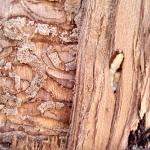 Emerald Ash Borer: (Agrilus planipennis, EAB) Since the New Year, the Massachusetts Department of Conservation and Recreation has confirmed at least 18 new community detections of emerald ash borer in Massachusetts. While the cities and towns with recent detections of EAB are too numerous to list here, they are in areas of Essex, Franklin, Hampshire, Middlesex, Norfolk, and Worcester counties. It is worthwhile to note that this was the first confirmation of EAB in Franklin County. A map of these locations and others previously known across the state may be found here: https://ag.umass.edu/fact-sheets/emerald-ash-borer .
Emerald Ash Borer: (Agrilus planipennis, EAB) Since the New Year, the Massachusetts Department of Conservation and Recreation has confirmed at least 18 new community detections of emerald ash borer in Massachusetts. While the cities and towns with recent detections of EAB are too numerous to list here, they are in areas of Essex, Franklin, Hampshire, Middlesex, Norfolk, and Worcester counties. It is worthwhile to note that this was the first confirmation of EAB in Franklin County. A map of these locations and others previously known across the state may be found here: https://ag.umass.edu/fact-sheets/emerald-ash-borer .
This wood-boring beetle readily attacks ash (Fraxinus spp.) including white, green, and black ash and has also been found developing in white fringe tree (Chionanthus virginicus) and has been reported in cultivated olive (Olea europaea). Adult insects of this species will not be present at this time of year. Signs of an EAB infested tree may include (at this time) D-shaped exit holes in the bark (from adult emergence in previous years), “blonding” or lighter coloration of the ash bark from woodpecker feeding (chipping away of the bark as they search for larvae beneath), and serpentine galleries visible through splits in the bark, from larval feeding beneath. Positive identification of an EAB-infested tree may not be possible with these signs individually on their own.
For further information about this insect, please visit: https://ag.umass.edu/fact-sheets/emerald-ash-borer . If you believe you have located EAB-infested ash trees, particularly in an area of Massachusetts not identified on the map provided, please report here: http://massnrc.org/pests/pestreports.htm .

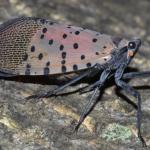 Spotted Lanternfly: (Lycorma delicatula, SLF) is not known to occur in Massachusetts landscapes (no established populations are known in MA at this time). However, due to the great ability of this insect to hitchhike using human-aided movement, it is important that we remain vigilant in Massachusetts and report any suspicious findings. Spotted lanternfly reports can be sent here:https://massnrc.org/pests/slfreport.aspx
Spotted Lanternfly: (Lycorma delicatula, SLF) is not known to occur in Massachusetts landscapes (no established populations are known in MA at this time). However, due to the great ability of this insect to hitchhike using human-aided movement, it is important that we remain vigilant in Massachusetts and report any suspicious findings. Spotted lanternfly reports can be sent here:https://massnrc.org/pests/slfreport.aspx
For a map of known, established populations of SLF as well as detections outside of these areas where individual finds of spotted lanternfly have occurred (but no infestations are present), visit: https://nysipm.cornell.edu/environment/invasive-species-exotic-pests/spotted-lanternfly/ This map depicts an individual find of spotted lanternfly at a private residence in Boston, MA that was reported by the MA Department of Agricultural Resources on February 21, 2019. More information about this detection in Boston, where no established infestation was found, is provided here: https://www.mass.gov/news/state-agricultural-officials-urge-residents-to-check-plants-for-spotted-lanternfly
This insect is a member of the Order Hemiptera (true bugs, cicadas, hoppers, aphids, and others) and the Family Fulgoridae, also known as planthoppers. The spotted lanternfly is a non-native species first detected in the United States in Berks County, Pennsylvania and confirmed on September 22, 2014.
The spotted lanternfly is considered native to China, India, and Vietnam. It has been introduced as a non-native insect to South Korea and Japan, prior to its detection in the United States. In South Korea, it is considered invasive and a pest of grapes and peaches. The spotted lanternfly has been reported from over 70 species of plants, including the following: tree of heaven (Ailanthus altissima) (preferred host), apple (Malus spp.), plum, cherry, peach, apricot (Prunus spp.), grape (Vitis spp.), pine (Pinus spp.), pignut hickory (Carya glabra), sassafras (Sassafras albidum), serviceberry (Amelanchier spp.), slippery elm (Ulmus rubra), tulip poplar (Liriodendron tulipifera), white ash (Fraxinus americana), willow (Salix spp.), American beech (Fagus grandifolia), American linden (Tilia americana), American sycamore (Platanus occidentalis), big-toothed aspen (Populus grandidentata), black birch (Betula lenta), black cherry (Prunus serotina), black gum (Nyssa sylvatica), black walnut (Juglans nigra), dogwood (Cornus spp.), Japanese snowbell (Styrax japonicus), maple (Acer spp.), oak (Quercus spp.), and paper birch (Betula papyrifera).
The adults and immatures of this species damage host plants by feeding on sap from stems, leaves, and the trunks of trees. In the springtime in Pennsylvania (late April - mid-May) nymphs (immatures) are found on smaller plants and vines and new growth of trees and shrubs. Third and fourth instar nymphs migrate to the tree of heaven and are observed feeding on trunks and branches. Trees may be found with sap weeping from the wounds caused by the insect’s feeding. The sugary secretions (excrement) created by this insect may coat the host plant, later leading to the growth of sooty mold. Insects such as wasps, hornets, bees, and ants may also be attracted to the sugary waste created by the lanternflies, or sap weeping from open wounds in the host plant. Host plants have been described as giving off a fermented odor when this insect is present.
Adults are present by the middle of July in Pennsylvania and begin laying eggs by late September and continue laying eggs through late November and even early December in that state. Adults may be found on the trunks of trees such as the tree of heaven or other host plants growing in close proximity to them. Egg masses of this insect are gray in color and look similar in some ways to gypsy moth egg masses.
Host plants, bricks, stone, lawn furniture, recreational vehicles, and other smooth surfaces can be inspected for egg masses. Egg masses laid on outdoor residential items such as those listed above may pose the greatest threat for spreading this insect via human aided movement.
For more information about the spotted lanternfly, visit this fact sheet: https://ag.umass.edu/landscape/fact-sheets/spotted-lanternfly .
Spring Scouting Suggestions:

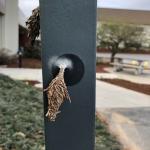
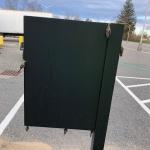 Bagworm: Thyridopteryx ephemeraeformis is a native species of moth whose larvae construct bag-like coverings over themselves with host plant leaves and twigs. This insect overwinters in the egg stage, within the bags of deceased females from last season. Eggs may hatch and young larvae are observed feeding around mid-June, or roughly between 600-900 GDD’s. Now is the time to scout for and remove and destroy overwintering bags. In certain areas across MA in 2019, increased populations of bagworms were observed and reported. More information can be found here: https://ag.umass.edu/landscape/fact-sheets/bagworm
Bagworm: Thyridopteryx ephemeraeformis is a native species of moth whose larvae construct bag-like coverings over themselves with host plant leaves and twigs. This insect overwinters in the egg stage, within the bags of deceased females from last season. Eggs may hatch and young larvae are observed feeding around mid-June, or roughly between 600-900 GDD’s. Now is the time to scout for and remove and destroy overwintering bags. In certain areas across MA in 2019, increased populations of bagworms were observed and reported. More information can be found here: https://ag.umass.edu/landscape/fact-sheets/bagworm- Balsam Twig Aphid: Mindarus abietinus overwinters as a silvery colored egg on host plant twigs. Eggs hatch just prior to budbreak and nymphs feed for a period of time on the undersides of last season’s needles before molting into a wingless stem mother. Stem mothers move to buds just as they open and give “live birth” to second generation nymphs. These second generation nymphs are the most damaging, feeding on new needles as they elongate, causing distortion and stunting. Excessive amounts of honeydew may be produced and cause needles to stick together. Foliar applications, if needed, may be made between 30-100 GDD’s, base 50°F on warm days before budcaps loosen. Inspect the twigs near the base of needles of Balsam fir, Fraser fir, and other true firs for overwintering eggs and soon after check the needles for feeding nymphs. This insect may be most problematic in Christmas tree production. In landscapes, many natural enemies can provide adequate management of this insect.
- Boxwood Leafminer: Monarthropalpus flavus partly grown fly larvae overwinter in the leaves of susceptible boxwood. Yellowish mines may be noticeable on the undersides of leaves. This insect grows rapidly in the spring, transforming into an orange-colored pupa. After pupation, adults will develop and white colored pupal cases may hang down from the underside of leaves where adults have emerged. Adults may be observed swarming hosts between 300-650 GDD’s, or roughly the end of May through June. Most cultivars of Buxus sempervirens and B. microphylla are thought to be susceptible. If installing new boxwoods this spring, resistant cultivars such as ‘Vardar Valley’ and ‘Handsworthiensis’ are good choices at sites where this insect has been a problem.
- Boxwood Mite: Eurytetranychus buxi overwinter as tiny eggs on boxwood leaves and hatch mid-spring. These mites are tiny (about the size of a period) and difficult to detect. Feeding may cause plants to appear off-color. If management is deemed necessary, the timing for treatment may be between 245-600 GDD’s or roughly the beginning of May.
- Boxwood Psyllid: Psylla buxi feeding can cause cupping of susceptible boxwood leaves. Leaf symptoms/damage may remain on plants for up to two years. English boxwood may be less severely impacted by this pest. Eggs overwinter, are buried in budscales, and hatch around budbreak of boxwood. Eggs may hatch around 80 GDD’s. Foliar applications may be made between 290-440 GDD’s. However, the damage caused by this insect is mostly aesthetic. Therefore, no management may be necessary.
- Cankerworms: Alsophila pometaria (fall cankerworm) and Paleacrita vernata (spring cankerworm) are often confused for winter moth (Operophtera brumata). Cankerworm populations in eastern MA, particularly on areas of Cape Cod, were confused for winter moth in 2019. Spring cankerworm adults were active in February and March, and fall cankerworm adults are active in late November into early December. During these times, both species lay eggs. These native insects most commonly utilize elm, apple, oak, linden, and beech. Eggs of both species hatch as soon as buds begin to open in the spring. Caterpillars occur in mixed populations and are often noticeable by mid-May in MA. Young larvae will feed on buds and unfolding leaves. There are two color forms (green and dark) for caterpillars of both species. Like winter moth, they will drop to the soil to pupate. This usually occurs in June. Fall cankerworm larvae have three pairs of prolegs (one of which is small so it is sometimes referred to as ½ pair) and spring cankerworm have two pairs. (Winter moth caterpillars also have 2 pairs of prolegs.) If populations are large and damage is noticeable on hosts, reduced risk insecticides such as Bacillus thuringiensis Kurstaki or spinosad may target larvae between 148-290 GDD’s.
- Cooley Spruce Gall Adelgid: Adelges cooleyi is a native insect that has a complex life cycle. It has at least five different morphological forms, and requires 2 years and two hosts to complete its normal life cycle. Galls (pineapple shaped/cone-like and at the tips of twigs) are produced on Colorado blue spruce, Engelmann, Sitka, and Oriental spruce and cause needle injury (yellow spots and distortion) to Douglas-fir. Immature females overwinter on spruce near twig terminals. In the early spring, females mature into stem mothers and lay hundreds of eggs on lateral terminals. Upon egg hatch, nymphs migrate to new spring growth and feed at the base of growing needles. Immatures can be targeted on spruce between 22-81 GDD’s (mid-late April). On Douglas-fir, dormant oil applications should be made immediately before budbreak to avoid phytotoxicity. Follow all label instructions.
- Eastern Spruce Gall Adelgid: Adelges abietis is a pest of Norway spruce primarily, but occasionally damages other spruce species such as Colorado blue, white, and red spruce. This adelgid overwinters as a partially grown female, often referred to as a stem mother. This overwintering individual matures around bud break and lays 100-200 eggs. The eastern spruce gall adelgid may be targeted for management between 22-170 GDD’s, base 50°F (mid-April to early-May). This insect is non-native, and was introduced into the United States from Europe before 1900. Galls are small, sometimes pineapple shaped/variable, but produced on the basal portion of the shoots, such that the twig extends beyond the gall. Twig dieback may occur.
- Eastern Tent Caterpillar: Malacosoma americanum eggs overwinter on host plant twigs. Egg hatch typically occurs when wild cherry leaves begin to unfold and young caterpillars may emerge by late-April through the first two weeks in May (90-190 GDD’s). Susceptible hosts include cherry and crabapple. Other host plants whose leaves are fed upon by this native insect can include apple, ash, birch, willow, maple, oak, poplar, and witch-hazel. Prune off and remove egg masses from ornamental host plants by early spring. Eastern tent caterpillars are native to Massachusetts and have many associated natural enemies (parasites and predators) that help regulate populations. Unless these caterpillars are actively defoliating specimen trees in a landscaped setting, we can coexist with this particular herbivore native to our forests.
- Elongate Hemlock Scale: Fiorinia externa is found on eastern, Carolina, and Japanese hemlock, as well as yew, spruce, and fir. The elongate hemlock scale may overwinter in various life stages, and the overlap of many developmental stages at any given time can be observed throughout much of the season. Dormant oil applications for this pest can occur according to label instructions in April, roughly between 7-120 GDD’s. Treatments for the crawler, or mobile, stage of this insect may be made in late May through mid-June, or between 360-700 GDD’s, base 50°F. Nitrogen fertilizer applications may make elongate hemlock scale infestations worse.
- Euonymus Scale: Unaspis euonymi is an armored scale that can be found on euonymus, holly, bittersweet, and pachysandra. This insect can cause yellow spotting on leaves, dieback, and distorted bark. Dormant oil applications can be made between 35-120 GDD’s or roughly from mid-April to early-May. For crawlers, early June timing is suggested between 533-820 GDD’s. (Eggs begin to hatch in early June.)
- European Pine Sawfly: Neodiprion sertifer overwinters in the egg stage. Eggs are laid by females the previous season by cutting slits in needles using their ovipositors and depositing 6-8 eggs in each of 10-12 needles. Egg hatch occurs from late-April to mid-May and caterpillars become active roughly between 78-220 GDD, base 50°F. The primary host in MA is Mugo pine but it can be found on Scots, red, jack, and Japanese red pine. It is also found on white, Austrian, ponderosa, shortleaf, and pitch pine when planted near the aforementioned species. This dark colored caterpillar feeds in tight groups and small numbers can be pruned or plucked out of host plants and destroyed. Spinosad products can be used whenever the caterpillars are actively feeding, usually by mid-May and when caterpillars are still small. Bacillus thuringiensis kurstaki is not effective against sawflies.
- Forest Tent Caterpillar: Malacosoma disstria egg hatch occurs between 192-363 GDD’s, base 50°F, by mid-late May and caterpillars may be active for at least 5-6 weeks following. Susceptible hosts whose leaves are fed on by this insect include oak, birch, ash, maple, elm, poplar, and basswood. This native insect has many natural enemies, including some very effective pathogens that typically regulate populations. However, outbreaks of this insect can occur on occasion.
- Hemlock Looper: Two species of geometrid moths in the genus Lambdina are native insects capable of defoliating eastern hemlock, balsam fir, and white spruce. Adult moths lay their eggs on the trunk and limbs of hosts in September and October, and eggs will hatch by late May or early June. (L. fiscellaria caterpillars may be active between 448-707 GDD’s.) Monitor susceptible hosts for small, inch-worm like caterpillars. Where populations are low, no management is necessary. Hemlock loopers have several effective natural enemies.
- Hemlock Woolly Adelgid: Adelges tsugae is present on eastern and Carolina hemlock. The overwintering hemlock woolly adelgid generation (sistens) is present through mid-spring and produces the spring generation (progrediens) which will be present from early spring through mid-summer. HWA, unlike many other insects, does most of its feeding over the winter. Eggs may be found in woolly masses at the base of hemlock needles beginning in mid-March. Each woolly mass is created by a female who may then lay 50-300 eggs. Eggs hatch and crawlers may be found from mid-March through mid-July. Infested trees may be treated with foliar sprays in late April to early May, using Japanese quince as a phenological indicator. Systemic applications may be made in the spring and fall, or when soil conditions are favorable for translocation to foliage. Nitrogen fertilizer applications may make hemlock woolly adelgid infestations worse.
- Imported Willow Leaf Beetle: Plagiodera versicolora adult beetles overwinter near susceptible hosts. Adult beetles will chew holes and notches in the leaves of willow once they become available. Females lay yellow eggs in clusters on the undersides of leaves. Larvae are slug-like and bluish-green in color. They will feed in clusters and skeletonize the leaves. Most plants can tolerate the feeding from this insect, and foliage will appear brown. Repeated yearly feeding can be an issue, in which case management of the young larvae may be necessary. Take care with treatment in areas near water.
- Lecanium Scales (Oak): Parthenolecanium quercifex overwinters as a second instar nymph on oak twigs. Females will begin feeding and mature in the spring, from mid-April to early May and eggs may be laid between late May and into June. Eggs hatch in June or early July and crawlers migrate to host plant leaves where they spend the summer and migrate as second instars back to host plant twigs in the fall. Mid-April to early-May (35-145 GDD’s) for dormant oil applications.
- Lily Leaf Beetle: Lilioceris lilii adults overwinter in sheltered places. As soon as susceptible hosts such as Lilium spp. (Turk’s cap, tiger, Easter, Asiatic, and Oriental lilies) and Fritillaria spp.break through the ground, the adult lily leaf beetles are known to feed on the new foliage. (Note: daylilies are not hosts.) Typically, in May, mating will occur and each female will begin to lay 250-450 eggs in neat rows on the underside of the foliage. If there are only a few plants in the garden, hand picking and destroying overwintering adults can help reduce local garden-level populations at this time.
- Magnolia Scale: Neolecanium cornuparvum overwinters as first instar nymphs which are elliptical, and dark slate gray in color and can usually be found on the undersides of 1 and 2 year old twigs. Nymphs may molt by late April or May and again by early June at which time the scales may be purple in color. Eventually nymphs secrete a white powdery layer of wax over their bodies. Dormant oils can be applied between 7-35 GDD’s targeting the overwintering nymphs. Avoid applications to opening buds or blooms.
- Pine Bark Adelgid: Pineus strobi overwinters as an immature which begins feeding during the first days of warm weather in the spring and begins secreting white wax over itself, which can eventually coat the entire trunk of infested trees. Egg laying may begin in April. This insect can be found on the trunk, branches, twigs, and the base of needles on new shoots. Spruce is a secondary host but this adelgid can repeatedly reproduce itself on pine. Wash off bark with a strong jet of water. If necessary, dormant oil applications can be made in mid-late April between 22-58 GDDs. Hosts include eastern white, Scots, and Austrian pines. This insect does little damage to healthy trees and can often be tolerated.
- Snowball Aphid: Neoceruraphis viburnicola eggs overwinter on viburnum twigs and buds. Eggs hatch and this aphid becomes active on certain species of viburnum roughly between 148-298 GDD’s or around redbud bloom. This insect is particularly noticeable on V. opulus, V. prunifolium, and V. acerifolia. Stem mothers, appearing blueish-white, can be found in curled up and distorted foliage. Damage caused by this insect pest is mostly aesthetic.
- Spruce Bud Scale: Physokermes piceae is a pest of Alberta and Norway spruce, among others. Immatures overwinter on the undersides of spruce needles, dormant until late March. By April, females may move to twigs to complete the rest of their development. Dormant oil applications may be made between 22-121 GDDs. Follow all label instructions, as oil may remove the bluish color from certain conifers. Mature scales are reddish brown, globular, 3 mm. in diameter, and found in clusters of 3-8 at the base of new twig growth. They closely resemble buds and are often overlooked. Crawlers are present around June.
- Spruce Spider Mite: Oligonychus ununguis is a cool-season mite that becomes active in the spring from tiny eggs that have overwintered on host plants. Hosts include spruce, arborvitae, juniper, hemlock, pine, Douglas-fir, and occasionally other conifers. This particular species becomes active in the spring and can feed, develop, and reproduce through roughly June. When hot, dry summer conditions begin, this spider mite will enter a summer-time dormant period (aestivation) until cooler temperatures return in the fall. This particular mite may prefer older needles to newer ones for food. When damaging spruce spider mite populations are known from last season, dormant oil applications can be made (when temperatures are appropriate according to label instructions) between 7-121 GDD’s, base 50°F (April). Magnification is required to view spruce spider mite eggs. Tapping host plant branches over white paper may be a useful tool when scouting for spider mite presence. (View with a hand lens.) Spider mite damage may appear on host plant needles as yellow stippling and occasionally fine silk webbing is visible.
- Viburnum Leaf Beetle: Pyrrhalta viburni is a beetle in the family Chrysomelidae that is native to Europe, but was found in Massachusetts in 2004. Viburnum leaf beetle overwinters as eggs laid in capped pits on the newest growth of susceptible viburnum branches. Scout for overwintered eggs and prune out and destroy before they hatch. Egg hatch occurs in late-April to early-May as temperatures warm and foliage becomes available. Monitor for larvae in mid-May (80-120 GDD’s). This beetle feeds exclusively on many different species of viburnum, which includes, but is not limited to, susceptible plants such as V. dentatum, V. nudum, V. opulus, V. propinquum, and V. rafinesquianum. Some viburnum have been observed to have varying levels of resistance to this insect, including but not limited to V. bodnantense, V. carlesii, V. davidii, V. plicatum, V. rhytidophyllum, V. setigerum, and V. sieboldii. More information about viburnum leaf beetle may be found at http://www.hort.cornell.edu/vlb/ .
- White Pine Weevil: Pissodes strobi adults overwinter in sheltered locations in the leaflitter and become active very early in the spring, when daytime temperatures reach 50°F and before the bloom of forsythia (between 7-58 GDDs). Hosts include eastern white pine, Norway spruce, scotch, pitch, and red pine, blue spruce, and white spruce are also susceptible to white pine weevil damage. Adults will begin feeding on bark 7-10 inches below dormant terminal buds. Females will deposit eggs in terminal growth bark, and developing larvae will feed in leaders until they mature in July when pupation occurs in pupal chambers made of wood chips. Management in nurseries or Christmas tree production may be necessary. Target adults between 7-58 GDD’s.
- Woolly Elm Aphid: Eriosoma americanum females lay a single egg in the cracks and crevices of elm bark, where the egg overwinters. Eggs hatch on elm in the spring as leaves are unfolding. Aphids may be active from 121-246 GDD’s, base 50°F on elm. A young, wingless female hatched from the egg feeds on the underside of leaf tissue. This female aphid matures and gives birth to 200 young, all females, without mating. These aphids feed, and the elm leaf curls around them and protects them. By the end of June, winged migrants mature and find serviceberry hosts. Another set of females is produced. These new females crawl to and begin feeding on the roots of serviceberry. Multiple generations occur on the roots of serviceberry through the summer.
Concerned that you may have found an invasive insect or suspicious damage caused by one? Need to report a pest sighting? If so, please visit the Massachusetts Introduced Pests Outreach Project: http://massnrc.org/pests/pestreports.htm .
A note about Tick Awareness: deer ticks (Ixodes scapularis), the American dog tick (Dermacentor variabilis), and the lone star tick (Amblyomma americanum) are all found throughout Massachusetts. Each can carry their own complement of diseases. Anyone working in tick habitats (wood-line areas, forested areas, and landscaped areas with ground cover) should check themselves regularly for ticks while practicing preventative measures. Have a tick and need it tested? Visit the web page of the UMass Laboratory of Medical Zoology (https://www.tickreport.com/ ) and click on the blue Order a TickReport button for more information.
Reported by Tawny Simisky, Extension Entomologist, UMass Extension Landscape, Nursery, & Urban Forestry Program
Additional Resources
To receive immediate notification when the next Landscape Message update is posted, join our email list by emailing your request to eweeks@umext.umass.edu with Subscribe Greeninfo in the subject line, and follow us on Facebook and Twitter.
For a complete listing of upcoming events, see our Upcoming Educational Events page.
For commercial growers of greenhouse crops and flowers - Check out UMass Extension's Greenhouse Update website
For professional turf managers - Check out Turf Management Updates
For home gardeners and garden retailers - Check out home lawn and garden resources. UMass Extension also has a Twitter feed that provides timely, daily gardening tips, sunrise and sunset times to home gardeners, see https://twitter.com/UMassGardenClip
Current Massachusetts and University policy have the effect of temporarily suspending most of the on-campus services that we provide, including but not limited to:
- Soil and Plant Nutrient Testing Lab
- Plant Disease Diagnostics Lab
- Weed, Insect, Turfgrass, and Invasive Plant Identification
Until further notice, please do not send or deliver samples to the campus, as we cannot process them.
Diagnostic Services
A UMass Laboratory Diagnoses Landscape and Turf Problems - The UMass Extension Plant Diagnostic Lab is available to serve commercial landscape contractors, turf managers, arborists, nurseries and other green industry professionals. It provides woody plant and turf disease analysis, woody plant and turf insect identification, turfgrass identification, weed identification, and offers a report of pest management strategies that are research based, economically sound and environmentally appropriate for the situation. Accurate diagnosis for a turf or landscape problem can often eliminate or reduce the need for pesticide use. For sampling procedures, detailed submission instructions and a list of fees, see Plant Diagnostics Laboratory . No samples are being accepted at this time.
Soil and Plant Nutrient Testing - The University of Massachusetts Soil and Plant Nutrient Testing Laboratory is located on the campus of The University of Massachusetts at Amherst. Testing services are available to all. The function of the Soil and Plant Nutrient Testing Laboratory is to provide test results and recommendations that lead to the wise and economical use of soils and soil amendments. For complete information, visit the UMass Soil and Plant Nutrient Testing Laboratory web site. Alternatively, call the lab at (413) 545-2311. No samples are being accepted at this time.
At this time, the TickReport Risk Assessment and Passive Surveillance Program, which is not part of UMass Extension, remains open. Tick samples can continue to be submitted via https://www.tickreport.com . Please contact TickReport with further questions and updates on the status of their service.
Ticks are active any time that temperatures are above freezing! Remember to take appropriate precautions when working and playing outdoors, and conduct daily tick checks. UMass tests ticks for the presence of Lyme disease and other disease pathogens. Learn more
